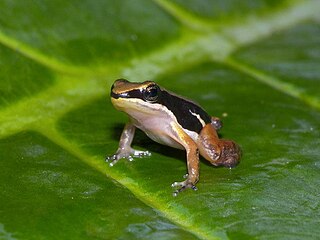
Colostethus is a genus of poison dart frogs native to Central and South America, from Panama south to Colombia, Ecuador, and northern Peru. Their common name is rocket frogs, but this name may refer to frogs in other genera and families, following the taxonomic revision of the genus in 2006.

Dendrobates is a genus of poison dart frogs native to Central and South America. It once contained numerous species, but most originally placed in this genus have been split off into other genera such as Adelphobates, Ameerega, Andinobates, Epipedobates, Excidobates, Oophaga, Phyllobates and Ranitomeya, leaving only five large to medium-sized species in the genus Dendrobates. All the other genera used to be grouped in with Dendrobates because it was previously thought that all brightly colored poison dart frogs came from the same ancestor but this has since been proven to be incorrect. Dendrobates and Phyllobates evolved conspicuous coloration from the same common ancestor but not the same as any of the other genera listed above.

Epipedobates is a genus of poison dart frogs native to northern South America west of the Andes, including the western slopes. Common name phantasmal poison frogs has been suggested for the genus.
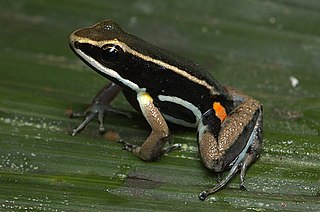
The Aromobatidae are a family of frogs native to Central and South America. They are sometimes referred to as cryptic forest frogs or cryptic poison frogs. They are the sister taxon of the Dendrobatidae, the poison dart frogs, but are not as toxic as most dendrobatids are.

The blue-bellied poison frog or bluebelly poison frog is a species of frog in the family Dendrobatidae.

Ranitomeya vanzolinii, also known as the Brazilian poison frog or spotted poison frog, is a species of frog in the Ranitomeya genus, from the poison dart frog family, Dendrobatidae. It is found in the Amazonian rainforests of Brazil and Perú, and possibly Bolivia.
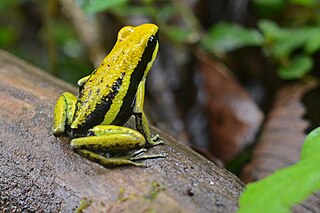
The pleasing poison frog is a species of frog in the family Dendrobatidae endemic to Peru. The specific name bassleri honors Harvey Bassler, an American geologist and paleontologist.
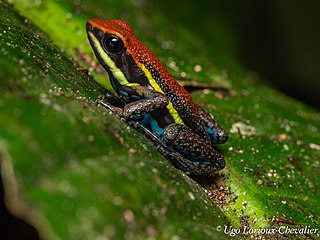
The Cainarachi poison frog is a species of frogs in the family Dendrobatidae. It is endemic to Amazonian Peru and found in the lowlands adjacent to the northern end of the Eastern Andes. It was named after the Rio Cainarache Valley, where it was first discovered.

The Manú poison frog is a frog species in the family Dendrobatidae found in southern Peru and Brazil. It can be found in the drainages of the Manú, Urubamba, Upper Purus and Ucayali Rivers. It can also be found in Serra do Divisor National Park and Alto Juruá Extractive Reserve.

The Peru poison frog, also known as Peruvian poison frog, Peruvian poison-arrow frog and emerald poison frog, is a species of frog in the family Dendrobatidae. It is found in eastern Peru and western Brazil. Its natural habitats are primary premontane and subtropical or tropical moist lowland forests, rivers, freshwater marshes, and intermittent freshwater marshes.
The Oxapampa poison frog is a species of frog in the family Dendrobatidae endemic to Peru near Oxapampa, in the Pasco Region. Its natural habitat is montane tropical rainforest. It is a very rare species threatened by habitat loss.
Silverstone's poison frog is a species of frog in the family Dendrobatidae endemic to Peru. Its natural habitats are subtropical or tropical moist lowland forests and rivers.

Hyloxalus is a genus of poison dart frogs, family Dendrobatidae. The genus is distributed in Central and South America, from Panama south to Peru, along with Venezuela, Colombia, and Ecuador. They also inhabit the eastern foothills of the Andes in Bolivia to Venezuela, east to the upper Amazon Basin.

Silverstoneia is a genus of poison dart frogs from southern Central America and northern South America, between southwestern Costa Rica and southwestern Colombia. It is named in honour of Phillip A. Silverstone, an expert on dendrobatoid frogs.

Adelphobates is a small genus of poison dart frogs. They are found in the central and lower Amazon basin of Peru and Brazil, possibly Bolivia. It was originally erected as a sister group to the Dendrobates and Oophaga genera. The validity of the genus is still being discussed, with the alternative being "Dendrobates galactonotus group" within Dendrobates. One species originally placed in this genus as Adelphobates captivus has since been moved to the genus Excidobates erected in 2008.
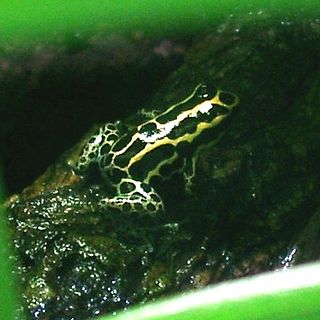
Ranitomeya is a genus of dart poison frogs found in Panama and South America south to Peru and Brazil, possibly into Bolivia.

Andinobates is a genus of poison dart frogs from Ecuador, Colombia and Panama. It contains species formerly classified in the genus Dendrobates and in 2006 transferred to the genus Ranitomeya. In 2011 Twomey, Brown, and their colleagues erected the genus Andinobates for a group of 12 species of Ranitomeya. Andinobates frogs can be distinguished from their sister taxon Ranitomeya anatomically in that their 2nd and 3rd vertebrae are fused. They show no limb reticulation, which is present in most species of Ranitomeya.
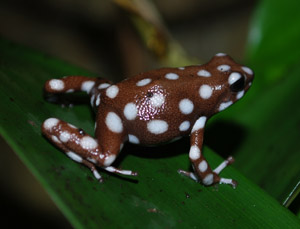
Excidobates is a genus of poison dart frogs endemic to the Marañón River drainage in Peru and Ecuador, South America. At one time members of this genus were classified as Dendrobates. A characteristic of this genus is the presence of pale, ovoid spots on the under surface of the thighs.

Ameerega boehmei is a species of frog in the family Dendrobatidae. It is endemic to the Chiquitania region in the Santa Cruz Department, Bolivia, where it is known from two isolated sandstone massifs, Serranía de Santiago and Serranía de Chochis. It is similar to Ameerega flavopicta and has been confused with that species. The specific name boehmei honors Wolfgang Böhme, for "his support of the scientific careers of all authors from early days on". Common name Boehmei's poison arrow frog has been proposed for this species.
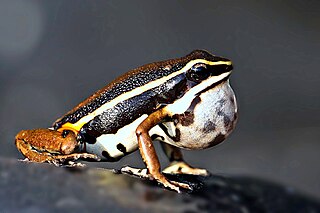
Ameerega munduruku is a species of poison dart frog in the family Dentrobatidae. It was described in 2017 by the herpetologist Matheus Neves and his colleagues, and is named after the Munduruku, an ethnic group native to Brazil. A medium-sized frog for its genus, it has a snout–vent length of 24.9–27.3 mm (0.98–1.07 in) for adult males and 20.4–28.6 mm (0.80–1.13 in) for adult females. It has black uppersides, with a cream stripe from the snout to the groin, white undersides with worm-like black markings, and brown uppersides to the limbs. There are orange spots on the armpit and lower leg and an orange stripe from the groin to the thigh. Both sexes are similar but can be told apart by the presence of vocal slits in males.




















